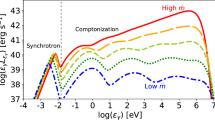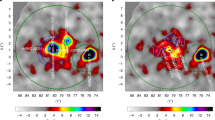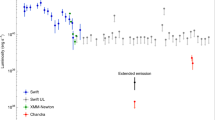Abstract
THE discovery of an X-ray source associated with the Crab Nebula1,2 has prompted an intensive search for X-ray sources associated with other known Type I supernovae, for example, Tycho, and Kepler3,4. So far this search has proved fruitless. One is thus led to wonder what essential differences between supernovae of the same type might result in the presence or absence of X-ray emission. Morrison and Sartori5 have proposed a thermal radiation model to account for this discrepancy. On the other hand, Woltjer6 has argued that the observed X-ray emission from the Crab Nebula is due to synchrotron radiation. I suggest that if Woltjer's hypothesis is correct, a critical part is played by the intensity of the early post-explosion radiation field; for this field, by way of the inverse Compton effect, limits the energy of the electrons in the supernova. In fact, I estimate that no extreme relativistic electrons (E > 1012 eV) can survive the first few weeks after the explosion. The situation is somewhat similar to that which gives rise to an upper bound on the energy of cosmic-ray electrons—the inverse Compton effect from starlight and synchrotron radiation in the galactic magnetic fields forcing a limit on the electron energy7.
This is a preview of subscription content, access via your institution
Access options
Subscribe to this journal
Receive 51 print issues and online access
$199.00 per year
only $3.90 per issue
Buy this article
- Purchase on Springer Link
- Instant access to full article PDF
Prices may be subject to local taxes which are calculated during checkout
Similar content being viewed by others
References
Gursky, H., Giacconi, R., Paolini, R., and Rossi, B., Phys. Rev. Letters, 11, 530 (1963).
Bowyer, S., Byram, E. T., Chubb, T. A., and Friedman, H., Nature, 201, 1307 (1964).
Bowyer, S., Byram, E. T., Chubb, T. A., and Friedman, H., Science, 147, 394 (1965).
Clark, G. W., Garmire, G., Oda, M., Wada, M., Giacconi, R., Gursky, H., and Waters, J., Nature, 205, 554 (1965).
Morrison, P., and Sartori, L., Phys. Rev. Letters, 14, 771 (1965).
Woltjer, L., Astrophys. J., 140, 1309 (1964).
Feenberg, E., and Primakoff, H., Phys. Rev., 72, 449 (1948).
Hewish, A., and Okoye, S., Nature, 207, 59 (1965).
Jones, F. C., Phys. Rev., 137, B1306 (1965).
Parker, E., Phys. Rev. Letters, 14, 55 (1965).
Author information
Authors and Affiliations
Rights and permissions
About this article
Cite this article
MANLEY, O. Early Radiation Field and High-energy Electrons in Supernovae. Nature 209, 901–902 (1966). https://doi.org/10.1038/209901a0
Issue Date:
DOI: https://doi.org/10.1038/209901a0
Comments
By submitting a comment you agree to abide by our Terms and Community Guidelines. If you find something abusive or that does not comply with our terms or guidelines please flag it as inappropriate.



